Colloquia for Fall 2016
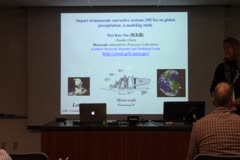
The impact of mesoscale convective systems on global precipitation: A modeling study
December 02, 2016
Wei-Kuo Tao
Hosted by Sue Van Den Heever
The importance of precipitating mesoscale convective systems (MCSs) has been quantified from TRMM precipitation radar and microwave imager retrievals. MCSs generate more than 50% of the rainfall in most tropical regions. Typical MCSs have horizontal scales of a few hundred kilometers (km); therefore, a large domain and high resolution are required for realistic simulations of MCSs in…
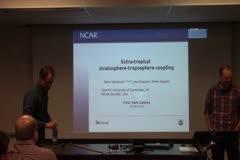
Downward influence from the Stratosphere in the extratropics
November 18, 2016
Peter Hitchcock
Hosted by Thomas Birner
Evidence from models and observations that the stratosphere imparts a significant downward influence on near-surface weather and climate has grown steadily since landmark papers in the early 2000s. It is now clear that the large-scale circulation in the stratosphere can be usefully exploited by seasonal forecasts, and that changes in this circulation are highly relevant both for understanding…
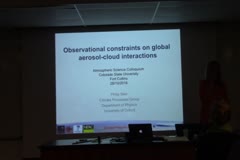
Observational Constraints on Global Aerosol-Cloud Interactions
October 28, 2016
Philip Stier
Hosted by Sue van den Heever
Aerosols arguably remain the single greatest uncertainty among anthropogenic perturbations of the climate system. In particular the effects of aerosol-cloud interactions on global and regional radiation budgets and the hydrological cycle remain highly uncertain. In this presentation, I will critically review some of the achievements made towards quantifying aerosol-cloud interactions in…
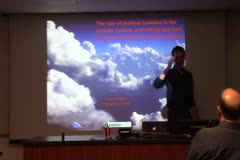
The role of shallow cumulus in the climate system, and asking how bad is "good enough" for climate models
October 21, 2016
Brian Medeiros
Hosted by Russ Schumacher
Shallow cumulus clouds predominate in the trade-wind regions, and the response of this widespread regime has been directly linked to the spread in climate model estimates of cloud feedback and climate sensitivity. These findings will be reviewed using CMIP5 climate model simulations. Observations and process-model simulations show that trade-wind regions foster multi-layered cloud structures…
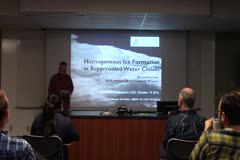
Homogeneous Ice Formation in Supercooled Water Clouds
October 14, 2016
Bernd Karcher
Hosted by Paul DeMott
It is important to know the phase and physical properties of aerosol and cloud particles at the top of mid-level and high tropospheric clouds – anvils and the stratiform cirrus that originate from them – in order to better estimate their effects on the atmospheric energy balance, the moisture budget and regional circulation patterns. This talk revisits the formation of pristine ice…
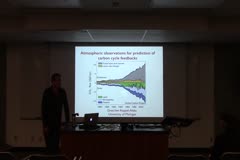
Quantifying carbon cycle feedbacks through the lens of atmospheric CO2 variations
October 07, 2016
Gretchen Keppel-Aleks
Hosted by Chris O’Dell
Carbon-cycle feedbacks are one of the most uncertain components of global climate predictions. Over the coming century, atmospheric CO2 will continue to accumulate in the atmosphere at a rate controlled by anthropogenic drivers, natural feedbacks to changing atmospheric composition, and the interaction thereof. In this talk, I will discuss Earth system model results that show the importance…
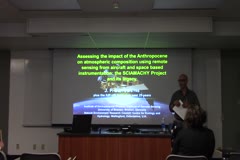
Assessing the impact of the Anthropocene on atmospheric composition using remote sensing from aircraft and space based instrumentation: the SCIAMACHY Project and its legacy
October 03, 2016
John P. Burrows
Hosted by A.R. Ravishankara
Between the dawn of the Neolithic revolution and the start industrial revolution the population rose from ~ 4 million to 1 billion using power provided predominantly from natural sources and biomass burning. Since the industrial revolution, world population has risen to over 7 billion, and now 50% are dwelling in urban areas. This has been accompanied by an equivalent rapid increase in the…
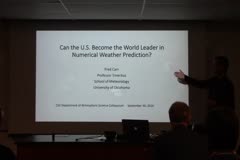
Can the U.S. Become the World Leader in Numerical Weather Prediction?
September 30, 2016
Fred Carr
Hosted by Russ Schumacher
It is well-known that the U.S. skill in numerical weather prediction (NWP), as measured by NCEP's Global Forecast System (GFS), lags behind other centers, most notably the ECMWF. In this talk, we will discuss some of the reasons for this discrepancy and provide a potential path forward for the U.S. to match or surpass ECMWF accuracy. In doing so, we will examine the strategic plans of various…
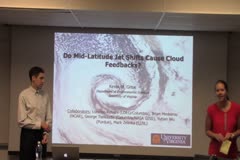
Do mid-latitude jet shifts cause cloud feedbacks?
September 23, 2016
Kevin Grise
Hosted by Libby Barnes
In response to increasing atmospheric greenhouse gas concentrations, most global climate models project that the mid-latitude jet streams will shift poleward over the 21st century. Consequently, the tracks of mid-latitude low-pressure systems and their associated cloud features are also anticipated to shift poleward over this time. As these cloud features move from a lower to a higher latitude,…
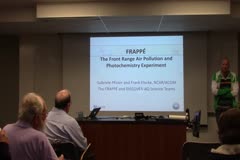
The Air You Breathe: An Overview and Early Results from the Front Range Air Pollution and Photochemistry Experiment (FRAPPE)
September 19, 2016
Gabriele Pfister and Frank Flocke (Visiting ATS from NCAR)
Hosted by Emily Fischer
The Front Range Air Pollution and Photochemistry Éxperiment (FRAPPÉ) was carried out in conjunction with the fourth deployment of the Deriving Information on Surface conditions from Column and Vertically Resolved Observations Relevant to Air Quality (DISCOVER-AQ) Mission in the summer of 2014. Four Aircraft, six mobile labs, and a number of instrumented ground sites were deployed over a…
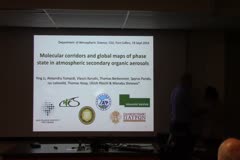
Molecular corridors and global maps of phase state in atmospheric secondary organic aerosols
September 19, 2016
Ying Li
Hosted by Jeff Collett and Shantanu Jathar from Mechanical Engineering
Secondary organic aerosols (SOA) account for a large fraction of submicron particles in the atmosphere and play a key role in aerosol effects on climate, air quality and public health. The formation and aging of SOA proceed through multiple steps of chemical reaction and mass transport in the gas and particle phases, which is challenging for the interpretation of field measurements and…
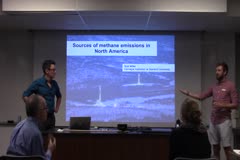
Sources of methane emissions in North America
September 12, 2016
Scot Miller
Hosted by Jakob Lindaas
Methane is the second-most important greenhouse gas after carbon dioxide. The role of methane emissions in climate change is well-known, but the distribution of these emissions from different sources across the globe and the underlying emissions processes are often poorly understood. My research uses observations of methane gas collected in the atmosphere to understand emissions at the Earth's…
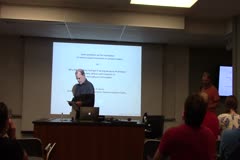
Some problems at the foundation of aerosol-cloud interaction in climate models or Why the IPCC may have got it wrong because of what we do to data, physics and numerics in bin-microphysics LES models
September 09, 2016
Jorgen B. Jensen
Hosted by David Randall
Autoconversion, that is the initial formation of drizzle drops from smaller cloud droplets through coalescence, is a critically important process to get right in climate models. Usually autoconversion is calculated through dependence on cloud droplet concentration and cloud liquid water mixing ratio. The more and the larger the cloud droplets are, the faster the autoconversion rate is…
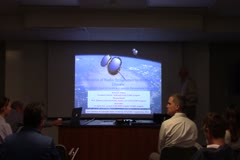
Contributions of Radio Occultation to Weather and Climate Using the world’s most accurate and precise thermometer from space
September 02, 2016
Richard A. Anthes, Therese Rieckh, Shay Gilpin
Hosted by Thomas H. Vonder Haar
Richard A. Anthes President Emeritus, UCAR and UCAR COSMIC program Therese Rieckh Ph.D. Student, University of Graz, Austria, and UCAR COSMIC program Shay Gilpin UC Santa Cruz , current UCAR SOARS student, COSMIC program The launch of the proof-of-concept mission GPS/MET (Global Positioning System/Meteorology) in 1995 began a revolution in profiling EarthÂ’s atmosphere…
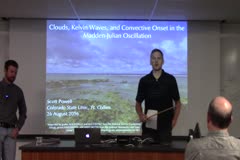
Clouds, Kelvin Waves, and Convective Onset in the Madden-Julian Oscillation
August 26, 2016
Scott Powell
Hosted by Eric Maloney
The Madden-Julian Oscillation (MJO) is a major component of sub-seasonal variability in tropical precipitation, and it also impacts extreme precipitation events in the subtropics and the mid-latitudes. Although it was discovered 45 years ago, the dynamics of its origin have long remained unclear and climate models continue to struggle with simulating realistic MJO events. The Dynamics of the…
